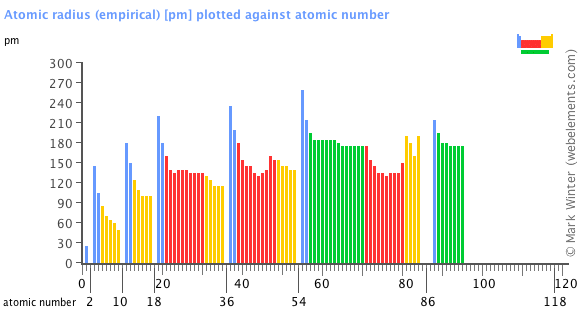

Hence crystal radius of oxygen = 132 / 2 = 66 pm. the distance between two oxygen atoms in molecular oxygen is 132 pm. Hence crystal radius of sodium = 372 / 2 = 186 pm.Ĭovalent radius is defined as one half of the distance between the centres of the two similar nuclei of two similar atoms bonded together by a single covalent bond. For e.g.

the distance between two sodium atoms in a sodium crystal is 372 pm. It is defined as one half of the distance between the centres of nuclei of two adjacent atoms in a metallic crystal. Other Terms Related to Atomic Radius: Crystal Radius: Hence the definition given in above point is arbitrary. The electron density in an atom is greatly influenced by the presence of other atoms around the bonding atom and the nature (type) of bonding with neighbouring atoms, Depending upon this the terms like crystal radius, covalent radius, van der Walls’ radius, tetrahedral radius, etc. The atomic radius (atomic size) may be regarded as the distance from the centre of the atom to the outermost (valence) shell of electrons. One practical approach of finding the size of an atom of a non-metallic element is to measure the distance between two atoms when they are bound together by a single bond in a covalent molecule and from this value, the “Covalent Radius” of the element can be calculated. Secondly, since the electron cloud surrounding the atom does not have a sharp boundary, the determination of the atomic size cannot be precise. Assuming atoms have a spherical shape, the radius of the sphere describes the size of the atom.The size of an atom is very small (120 pm). Group: A column of elements in the periodic table of the chemical elements.Ītomic radius: A measure of the size of an atom. Period: A horizontal row in the periodic table, which signifies the total number of electron shells in an element’s atom.

When moving down a group of the periodic table, the atomic radius increases because of the presence of additional principal energy levels, which are further away from the nucleus.As the atomic number increases along each row of the periodic table, the additional electrons go into the same outermost shell, causing the atomic radius to decrease due to the increasing nuclear charge.For instance, the radii generally decrease along each period (row) of the table from left to right and increase down each group (column). Atomic radii vary predictably across the periodic table.

Sample Test C/P Section Passage 2 Question 7 Therefore, atomic size, or radius, increases as one moves down a group in the periodic table.Īpplications of Hard-Soft Acid-Base theoryĬhemistry Question Pack Passage 6 Question 29 In a noble gas, the outermost level is completely filled therefore, the additional electron that the following alkali metal (Group I) possesses will go into the next principal energy level, accounting for the increase in the atomic radius. The principal energy levels hold electrons at increasing radii from the nucleus. Therefore, the size of atoms decreases as one moves across a period from left to right in the periodic table.


 0 kommentar(er)
0 kommentar(er)
